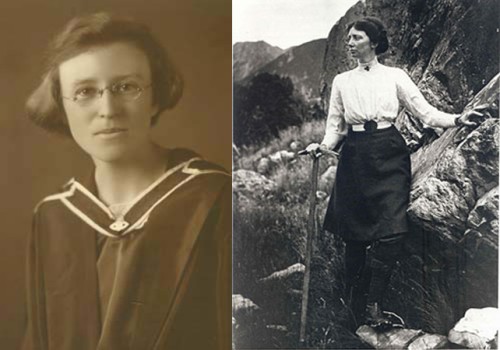Once when trekking in the Himalayas I had to follow my Nepalese guide as he chipped footholds into a sloping sheet of half frozen snow on the side of a mountain. One slip and I would have been on my way - and it seemed to me to be a long way down. That traverse took four minutes. They were four minutes that I as a non-hero would never want to experience again. I am in awe of the courage of mountaineers who live life on the edge.
When climbing, mountaineers are exposed to sub-zero temperatures, gales which threaten to blow them away and sometimes many hours gasping on thin air. As soon as one life-threatening situation is safely negotiated, another awaits around the next corner. It is an environment beyond the understanding of ordinary people.
Today’s climbing clothing is weatherproof and the equipment is light and strong. What of those who climbed before the high-tech? A bigger question is; what of female climbers in that low-tech era when females were expected to leave the physically dangerous activities to males? Such trailblazers were Marie Byles (1900-1979) who is a legend in my bushwalking club and her friend Freda du Faur (1882-1935). (The material on the web for Marie focuses on her activism and trivialises the danger and hardship she took upon herself in her pursuit of adventure - because that material was not written by an adventurer.)
Advertisement
I feel that a few words about Marie and Freda would be relevant in 2010 - the 40th anniversary of the publication of The Female Eunuch. The author Germaine Greer put forward the theory that women remain ultimately under the control of men - with the obliging women adjusting themselves to the male image of what women should be.
That seemed to be a plausible theory - but, before Greer was born there were women sharing wilderness adventures with men who were their admiring team mates.

Marie Byles and Freda du Faur (the picture of Freda is reproduced with the permission of SCEGGS Darlinghurst).
Marie was the first woman to break through the barrier and practice law in New South Wales. It must have rankled the establishment that here was a woman who could not be controlled. In the 1920s and 1930s in New Zealand she climbed and she explored. Away from the world of flabby men in suits and shiny shoes, Marie found that there are no male barriers to females in wilderness activities where only ability and character are the measure of a person. It is a social environment free of manipulation.
Her youthful stamina and daring was, with advancing age, gradually replaced with a passion for Eastern philosophy which she studied in several countries in Asia. Her passion for justice led her to become a prolific writer of pamphlets and magazine and newspaper articles. She authored six books.
Advertisement
Marie was disinterested in men, and women who are disinterested in men tend to develop personalities as they age which the male ego finds alienating. My late friend Dot Butler, who was close to Marie, informed me that Marie had this problem. While sleeping on her verandah in Sydney, Marie was bludgeoned. She spent months in hospital and was left with some permanent neural damage. Nobody was ever charged, but the husband of a woman she was acting for in a legal matter was suspected.
She died at age 79. In her last weeks she refused all pain relief in keeping with her Eastern philosophy. She was a woman determined to be the only one in control of herself. Said she: “Ignore the suffering - and it will go.” In her younger days when the slightest miscalculation would have sent her hurtling to her death, she must have said to herself: “These rocks are my friends and I caress them.” What an extraordinarily positive human being!
(The actual words “These rocks are my friends and I caress them” was said by the barefoot rock climber - Dot Butler (1911-2008). Marie would have had to think exactly the same if she was to get to the top and down again.)
Discuss in our Forums
See what other readers are saying about this article!
Click here to read & post comments.
58 posts so far.